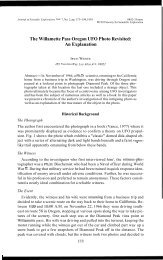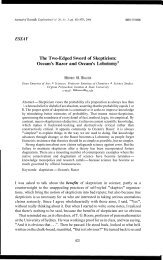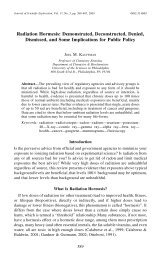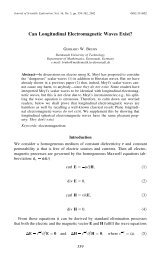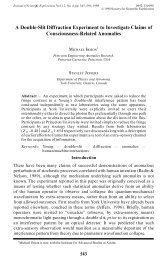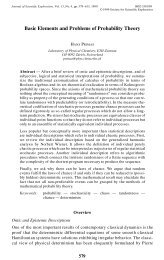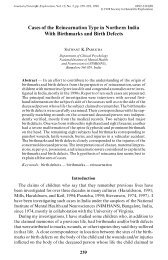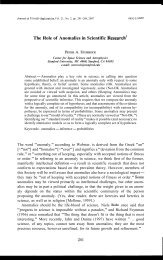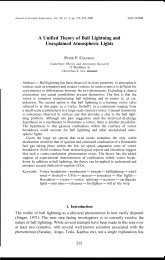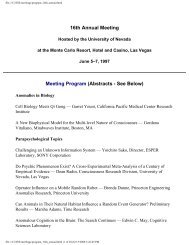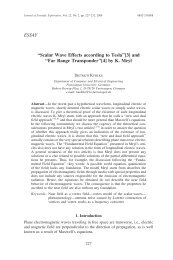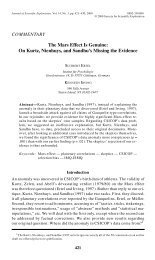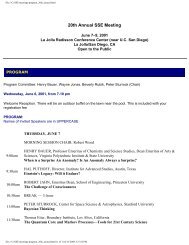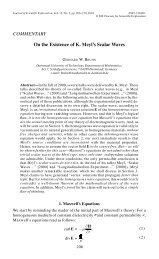REVIEW ARTICLE Ufology: What Have We Learned? - Society for ...
REVIEW ARTICLE Ufology: What Have We Learned? - Society for ...
REVIEW ARTICLE Ufology: What Have We Learned? - Society for ...
You also want an ePaper? Increase the reach of your titles
YUMPU automatically turns print PDFs into web optimized ePapers that Google loves.
566 M. D. Swords<br />
Fig. 17. Donald Menzel ready to go to war against James McDonald, while innocent bystander<br />
(William Powell, a pilot) gets caught in the middle. (NICAP)<br />
weakness in our society, which could be exploited by an enemy, and there<strong>for</strong>e<br />
this belief must be quashed. Speaking of his friend Robertson, he said that<br />
"Bob" had always been hostile to the idea of UFOs well be<strong>for</strong>e chairing<br />
the panel "but perhaps we better not mention that point" in the book53.<br />
SET1 enthusiasm ploughed <strong>for</strong>ward but now the UFOs were flapping again.<br />
Nineteen sixty-five and 1966 were dense UFO years and during them a very<br />
young and naive SETIan made a blunder. In the spring 1966 meeting of the<br />
American Astronautical <strong>Society</strong>, Carl Sagan, then of Harvard (no less), stole the<br />
show by stating that spacemen "may have visited Earth thousands of times in<br />
the past few billions of years" and, worse than that, "at least one of these visits<br />
may have occurred in historical times."54 Hmm. Sort of sounds like UFOs. Some<br />
of Sagan's colleagues thought so, too. People like Menzel and Condon remarked<br />
about Sagan in letters: was he dependable, solid, in his thinking?55 Did he have<br />
kookish tendencies like Allen Hynek or Jim McDonald, those renegades who<br />
thought something important existed in the phenomenon? (Figure 17) Condon<br />
wondered whether Sagan's softness on this was reason <strong>for</strong> excluding him<br />
from the honor of belonging to the elite Cosmos Club in D.C., an honor he hoped<br />
had already been denied to Allen Hynek. It took the headstrong young<br />
Sagan a while to get completely into line but once he did, he blossomed into<br />
the second most effective public scientist debunking UFOs (behind Menzel).<br />
One wonders: did Cosmos parlay into Cosmos Club?<br />
As the flap roared on, a major television network decided that it had to address<br />
all this silliness. CBS, with the Face That Told the Truth, Walter Cronkite,<br />
produced a UFO special: UFOs: Friend, Foe or Fantasy? It aired in May 1966<br />
and, of course, featured Donald Menzel. Covertly, it also featured something<br />
else. Somehow, CBS had chosen as scientific advisor to the program a man<br />
named Thornton Page. This was the same Doctor Page, who was an intelligence<br />
community scientist during the <strong>for</strong>ties and fifties, and who had served on the<br />
Robertson (CIA) Panel in 1953, as mentioned above (Figure 18). That panel had<br />
made specific, media-strategic recommendations on how to make UFOs appear<br />
empty of content, and even foolish. After the CBS broadcast, Page wrote to the



